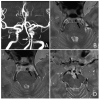Evaluating intracranial atherosclerosis rather than intracranial stenosis
- PMID: 24399377
- PMCID: PMC3957430
- DOI: 10.1161/STROKEAHA.113.002491
Evaluating intracranial atherosclerosis rather than intracranial stenosis
Keywords: collateral circulation; fractional flow reserve, myocardial; intracranial arteriosclerosis; neuroimaging.
Figures



Similar articles
-
Noninvasive imaging is improving but digital subtraction angiography remains the gold standard.Neurology. 2007 Jun 12;68(24):2057-8. doi: 10.1212/01.wnl.0000268580.86336.af. Neurology. 2007. PMID: 17562825 No abstract available.
-
Velocity criteria for intracranial stenosis revisited: an international multicenter study of transcranial Doppler and digital subtraction angiography.Stroke. 2011 Dec;42(12):3429-34. doi: 10.1161/STROKEAHA.111.621235. Epub 2011 Sep 29. Stroke. 2011. PMID: 21960567
-
Transcranial color-coded duplex sonography, magnetic resonance angiography, and computed tomography angiography: methods, applications, advantages, and limitations.J Clin Ultrasound. 1995 Feb;23(2):89-111. doi: 10.1002/jcu.1870230205. J Clin Ultrasound. 1995. PMID: 7699104 Review.
-
Significance of good collateral compensation in symptomatic intracranial atherosclerosis.Cerebrovasc Dis. 2012;33(6):517-24. doi: 10.1159/000337332. Epub 2012 Apr 25. Cerebrovasc Dis. 2012. PMID: 22538868
-
MR arteriography of intracranial circulation.AJR Am J Roentgenol. 1998 Dec;171(6):1469-78. doi: 10.2214/ajr.171.6.9843273. AJR Am J Roentgenol. 1998. PMID: 9843273 Review. No abstract available.
Cited by
-
Functional assessment of cerebral artery stenosis: A pilot study based on computational fluid dynamics.J Cereb Blood Flow Metab. 2017 Jul;37(7):2567-2576. doi: 10.1177/0271678X16671321. Epub 2016 Jan 1. J Cereb Blood Flow Metab. 2017. PMID: 27702878 Free PMC article.
-
High-resolution magnetic resonance imaging features of time-of-flight magnetic resonance angiography signal loss and its relevance to ischemic stroke.Quant Imaging Med Surg. 2024 Sep 1;14(9):6820-6829. doi: 10.21037/qims-24-329. Epub 2024 Aug 29. Quant Imaging Med Surg. 2024. PMID: 39281140 Free PMC article.
-
Transcranial Doppler Ultrasonography as a Diagnostic Tool for Cerebrovascular Disorders.Front Hum Neurosci. 2022 Apr 29;16:841809. doi: 10.3389/fnhum.2022.841809. eCollection 2022. Front Hum Neurosci. 2022. PMID: 35572008 Free PMC article. Review.
-
Noninvasive quantification of cerebrovascular pressure changes using 4D Flow MRI.Magn Reson Med. 2021 Dec;86(6):3096-3110. doi: 10.1002/mrm.28928. Epub 2021 Aug 25. Magn Reson Med. 2021. PMID: 34431550 Free PMC article.
-
Association of Lp-PLA2 Mass and Aysmptomatic Intracranial and Extracranial Arterial Stenosis in Hypertension Patients.PLoS One. 2015 Jun 22;10(6):e0130473. doi: 10.1371/journal.pone.0130473. eCollection 2015. PLoS One. 2015. PMID: 26098634 Free PMC article.
References
-
- Qureshi AI, Feldmann E, Gomez CR, Johnston SC, Kasner SE, Quick DC, et al. Intracranial atherosclerotic disease: an update. Ann Neurol. 2009;66:730–738. - PubMed
-
- Chimowitz MI, Lynn MJ, Howlett-Smith H, Stern BJ, Hertzberg VS, Frankel MR, et al. Comparison of warfarin and aspirin for symptomatic intracranial arterial stenosis. N Engl J Med. 2005;352:1305–1316. - PubMed
-
- Feldmann E. Diagnosis and quantitation of intracranial stenosis. J Neuroimaging. 2009;19(Suppl 1):22S–24S. - PubMed
-
- Kasner SE, Chimowitz MI, Lynn MJ, Howlett-Smith H, Stern BJ, Hertzberg VS, et al. Predictors of ischemic stroke in the territory of a symptomatic intracranial arterial stenosis. Circulation. 2006;113:555–563. - PubMed
Publication types
MeSH terms
Grants and funding
LinkOut - more resources
Full Text Sources
Other Literature Sources
Medical

